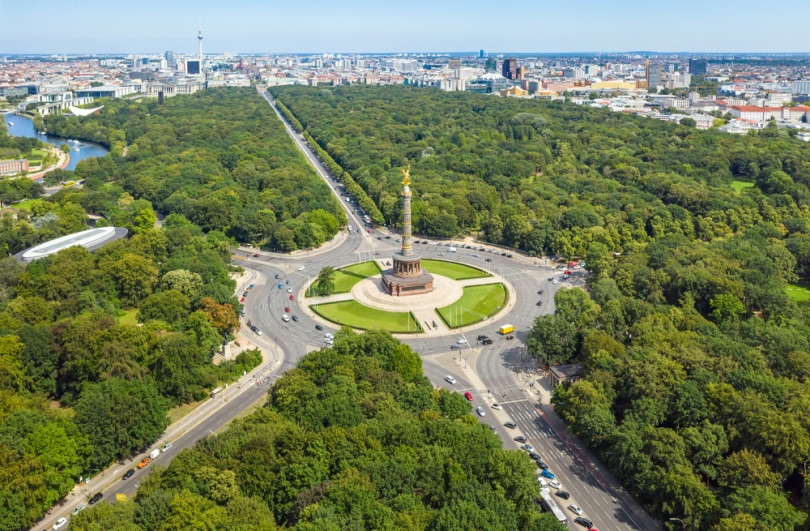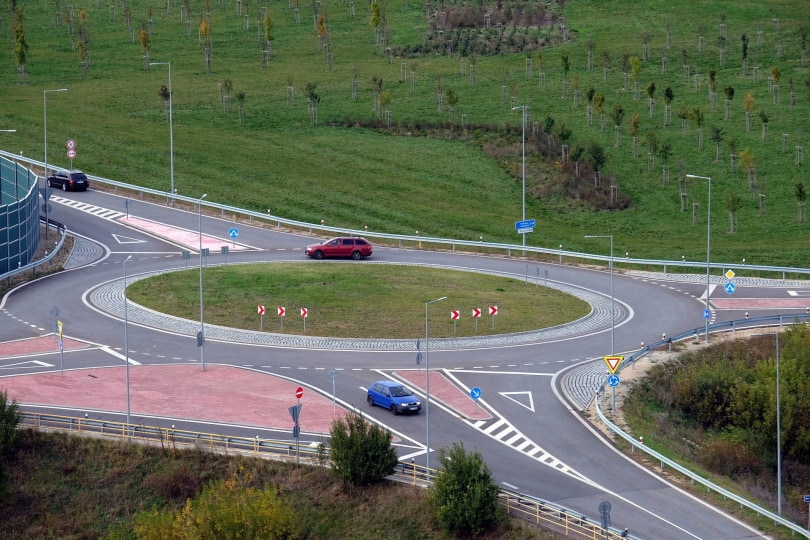Can We Reduce Carbon Emissions With Roundabouts? Benefits, Facts & FAQs
-
- Last updated:

Among their many benefits, it turns out that roundabouts are an effective way to reduce carbon emissions. The modern roundabout can be a confusing inconvenience to some motorists, but there’s no doubt that everyone is benefiting from them. They may not realize it, but drivers enjoy a safer, more efficient approach to traffic control every time they pull up to the “Yield” sign.
Some benefits of roundabouts become crystal clear when you see them in action. But when it comes to reducing our carbon footprint, can roundabouts make a meaningful difference? We’ll explore how much a roundabout can affect carbon emissions and discuss why these simple setups make such an impact.

What Is a Roundabout?
A modern roundabout is similar to a traffic circle or rotary, consisting of a circular junction and several entry/exit points. You’ll find them in high-traffic areas where a 4-way stop or stop lights might go instead. Unlike other intersections, a roundabout limits vehicles to speeds around 20 mph rather than making them come to complete stops. They’re also easier to adapt to unique traffic arrangements, such as a 5-way intersection.
Roundabouts differ from traffic circles in several ways, both in form and function. They’re smaller than traffic circles, with 1 or 2-lane roundabouts measuring between 100’ to over 200’ in diameter. The right of way goes to traffic already in the intersection. Unlike in traffic circles, drivers have to yield to pedestrians and traffic before entering.

Can We Reduce Carbon Emissions with Roundabouts?
For years, industry experts have been looking into how roundabouts affect emissions. The EPA estimates that 29% of U.S. greenhouse gasses stem from the transportation sector. There could be enormous opportunities to impact air quality and reduce pollution with more intelligent practices in this arena.
Several studies in the United States and Europe compared roundabouts to other types of intersections, and they agree that changing to roundabouts reduces carbon emissions. Experts note that the effects are greater during lighter traffic. When there is heavy traffic, the emissions can equal those of traditional stop-controlled intersections.
One study from Kansas State University examined how modern roundabouts reduce vehicular emissions. Researchers looked at six locations where roundabouts took the place of stop-controlled intersections. The sites saw varying levels of traffic, ranging from 156 vehicles per hour to 2024 vehicles per hour. Researchers taped and analyzed traffic patterns to assess the emission rate for the following hazards:
- Carbon dioxide (CO2)
- Carbon monoxide (CO)
- Oxides of nitrogen (NOx)
- Hydrocarbons (HC)

They found that CO emissions were 21% lower in the morning at roundabouts than at their stop-controlled counterparts. In the evening, they were 42% lower at the roundabout. Oxides of nitrogen were 48% lower in the evening, while CO2 and hydrocarbon emissions were 59% and 65% lower, respectively.
Those findings were consistent with other papers on roundabouts. A study from Sweden found that CO emissions declined by 29% and NOx emissions went down by 21% when a roundabout took the place of a stoplight. In another study from Switzerland, they cut emissions and fuel consumption by roughly 17%.
How Do Roundabouts Cut Down on Emissions?
Roundabouts cut down on emissions by getting rid of the delays and queues that plague stop-based intersections. Traffic is always moving in a roundabout, but cars have to stop at red lights, even when there is no cross-traffic. Plus, roundabouts can use more than one traffic lane to handle higher traffic volumes with fewer space requirements.
Vehicles that are idling or accelerating hard produce more emissions than slow-moving vehicles. According to one expert, idling cars can produce up to 7 times more CO than a car traveling at 10 mph. One study concluded that a 35 km/h (~22 mph) approaching speed could have the most substantial impact on limiting CO2 emissions.

More Than Emissions: The Benefits of Roundabouts
With shorter queues and fewer delays, Mother Nature isn’t the only one who benefits from the efficiency of roundabouts. Along with emissions, they also reduce queue holds and fuel consumption, saving drivers tons of time and money. Some experts estimate that replacing traffic lights and stop signs with roundabouts can cut gas consumption by up to 34% and delays by 62%–74%.
Safety
While their efficiency is incredible, the primary appeal of roundabouts has always been safety. The possibility of severe accidents like T-bone and head-on collisions is extremely low in a roundabout. The IIHS found that injury crashes fell an incredible 72–80% when intersections changed to roundabouts. Meanwhile, the total number of crashes went down 35–47%.
For a fantastic case study on the benefits of roundabouts, look no further than Carmel, IN, the country’s roundabout capital. A NY Times story revealed that the city reduced injury crashes by almost 50% at 64 of their 140 roundabouts. Carmel suffered only 1.9 traffic deaths per 100,000 people in 2020, far below the national average of 12.4 traffic deaths per 100,000 people.
Pedestrians are also safer at roundabouts than at standard 4-way stops. Thanks to lane-splitting islands, they only have to worry about crossing one lane at a time. And with cars accelerating at slower, steadier paces, there’s a lower likelihood of an accident.

Energy Savings
A significant benefit of roundabouts over traffic signals is that they always work. They don’t rely on electricity, meaning there’s no concern that they’ll be unusable in a bad storm. Plus, they further contribute to energy savings by staying off the grid. They have no moving or powered parts. As a result, the service life is roughly 2.5 times longer than a standard traffic light, making maintenance far less expensive.

Final Thoughts
There’s plenty to love about the safety, efficiency, and aesthetics of roundabouts. If the residents in Carmel are any indication, it doesn’t take long to realize the positive effects they can have on your daily drive. Once you start using them, you can’t do without them. And with how much roundabouts can reduce carbon emissions, widespread use could truly make all the difference in the world.
See also: How To Be Carbon Neutral: 16 Ideas To Cut Your Carbon Footprint
Featured Image Credit: immudium, Shutterstock
Contents

